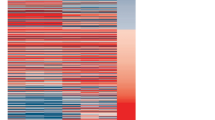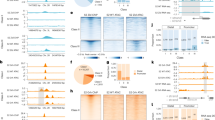Abstract
THE TATA-binding protein TBP is necessary for the transcription of eukaryotic genes. Multi-protein complexes formed by TBP and different TBP-associated factors are involved in the initiation of transcription by polymerases I and II, and probably III as well1. During the formation of an active initiation complex, TBP makes specific contacts with other proteins, for example TFIIB and RNA polymerase II (refs 2-4). Here we describe the cloning and characterization of a Drosophila gene product with considerable sequence similarity to TBP and a highly restricted expression pattern in the embryo. This TBP-related factor is a DNA-binding protein but is not likely to be a basal transcription factor. Our results suggest that TBP-related factor is a sequence-specific transcription factor that shares the DNA-binding properties of TBP.
This is a preview of subscription content, access via your institution
Access options
Subscribe to this journal
Receive 51 print issues and online access
$199.00 per year
only $3.90 per issue
Buy this article
- Purchase on Springer Link
- Instant access to full article PDF
Prices may be subject to local taxes which are calculated during checkout
Similar content being viewed by others
References
Gill, G. Curr. Biol. 2, 565–567 (1992).
Buratowski, S., Hahn, S., Guarente, L. & Sharp, P. A. Cell 56, 549–561 (1989).
Usheva, A. et al. Cell 69, 871–881 (1992)
Ha, I., Lane, W. & Reinberg, D. Nature 352, 689–695 (1991).
Bier, E. et al. Genes Dev. 3, 1273–1287 (1989).
Papazian, D. M., Schwarz, T. L. Tempel, B. L., Timpe, L. C. & Jan, L. Y. A. Rev Physiol. 50, 379–394 (1988).
Sink, H. & Whitington, P. M. Development 112, 307–316 (1991).
Jacobs, J. R., Hiromi, Y., Patel, N. H. & Goodman, C. S. Neuron 2, 1625–1631 (1989).
Hoey, T., Dynlacht, B. D., Peterson, M. G., Pugh, B. F. & Tjian, R. Cell 61, 1179–1186 (1990).
Hoffman, A. et al. Nature 346, 387–390 (1990).
Peterson, M. G., Tanese, N., Pugh, B. F. & Tjian, R. Science 248, 1625–1630 (1990).
Horikoshi, M., Yamamoto, T., Ohkuma, Y., Weil, P. A. & Roeder, R. G. Cell 61, 1171–1178 (1990).
Nash, H. A. & Granston, A. E. Cell 67, 1037–1038 (1991).
Reddy, P. & Hahn, S. Cell 65, 349–357 (1991).
Strubin, M. & Struhl, K. Cell 68, 721–730 (1992).
Pugh, B. F. & Tjian, R. Cell 61, 1187–1197 (1990).
Hu, S. L. & Manley, J. L. Proc. natn. Acad. Sci. U.S.A. 78, 820–824 (1981).
Lillie, J. W. & Green, M. R. Nature 338, 39–44 (1989).
Dynlacht, B. D., Hoey, T. & Tjian, R. Cell 66, 563–576 (1991).
Schultz, M. C., Reeder, R. H. & Hahn, S. Cell 69, 697–702 (1992).
Tautz, D. & Pfeifle, C. Chromosoma 98, 81–85 (1989).
Bier, E., Jan, L. Y. & Jan, Y. N. Genes Dev. 4, 190–203 (1990).
Campos-Ortega, J. A. & Hartenstein, V. The Embryonic Development of Drosophila melanogaster (Springer, New York, 1985).
Studier, F. W. and Moffat, B. A. J. molec. Biol. 189, 113–130 (1986).
Rosenberg, A. H. et al. Gene 56, 125–135 (1987).
Wampler, S. L., Tyree, C. M. & Kadonaga, J. T. J. biol. Chem. 265, 1223–2123 (1990).
Author information
Authors and Affiliations
Rights and permissions
About this article
Cite this article
Crowley, T., Hoey, T., Liu, JK. et al. A new factor related to TATA-binding protein has highly restricted expression patterns in Drosophila. Nature 361, 557–561 (1993). https://doi.org/10.1038/361557a0
Received:
Accepted:
Issue Date:
DOI: https://doi.org/10.1038/361557a0
This article is cited by
-
Molecular determinants underlying functional innovations of TBP and their impact on transcription initiation
Nature Communications (2020)
-
The Entamoeba histolytica TBP and TRF1 transcription factors are GAAC-box binding proteins, which display differential gene expression under different stress stimuli and during the interaction with mammalian cells
Parasites & Vectors (2018)
-
TRF2 is recruited to the pre-initiation complex as a testis-specific subunit of TFIIA/ALF to promote haploid cell gene expression
Scientific Reports (2016)
-
Dendritic cell CD83 homotypic interactions regulate inflammation and promote mucosal homeostasis
Mucosal Immunology (2015)
-
TBP-related factors: a paradigm of diversity in transcription initiation
Cell & Bioscience (2011)
Comments
By submitting a comment you agree to abide by our Terms and Community Guidelines. If you find something abusive or that does not comply with our terms or guidelines please flag it as inappropriate.



